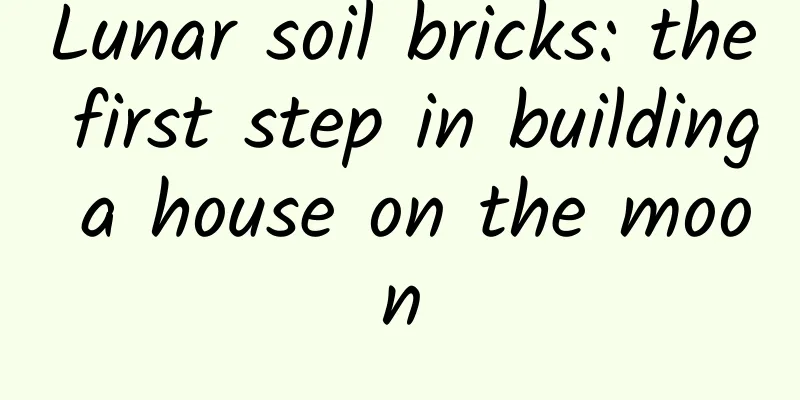Lunar soil bricks: the first step in building a house on the moon

|
As my country's lunar exploration project continues to advance, building a house on the moon has become a planning goal of the lunar exploration project. Since we need to build a house, we need building materials, and the research of "lunar soil bricks" has also been put on the agenda. On September 1, 2024, in the program "The First Lesson of School", the scientist team brought the latest lunar soil bricks, which were very novel. Building a house on the moon is not out of reach The construction of the lunar surface was proposed as human beings landed on the moon. In 1969, after the first human landing on the moon, the world launched a research boom on lunar surface construction technology. The technical path proposed at that time was all ground research and development, transportation and launch, and direct application on the lunar surface. From 1993 to 2018, the research on lunar surface construction has been further developed. NASA proposed the concept of "lunar outpost" and the European Space Agency proposed the concept of "lunar habitat". The main technical path is ground research, lunar surface deployment, lunar surface expansion and maintenance. However, compared with traditional construction, the problems and challenges faced by lunar construction are very complex. The first is to overcome the test of extreme environments such as weak gravity and strong radiation. Secondly, the moon is in an ultra-high vacuum environment, and there is a temperature difference of more than 300 degrees Celsius. Traditional civil construction methods are almost impossible to implement, and structural stability cannot be guaranteed. In addition, the high cost also means that it is impractical to transport building materials such as steel bars, concrete, and water from the earth to the moon. In addition, because there is no protection from the atmosphere, strong radiation from cosmic rays, solar wind, micrometeorites, etc. will hit the surface of the moon. At the same time, the moon has about 1,000 moonquakes of magnitude 2-3 every year. These will place stringent requirements on the mechanical properties, thermal properties, and radiation resistance of lunar construction materials. Moon surface Faced with this common technological issue for mankind, Chinese scientists have put forward their own thoughts, which is to make full use of the on-site resources on the moon under the existing conditions, combine mature ground construction technology, and innovatively build a lunar human-machine collaborative construction system to realize the intelligent implementation of lunar construction. In 2015, Ding Lieyun, an academician of the Chinese Academy of Engineering and chief scientist of the National Digital Construction Technology Innovation Center, was inspired by architectural 3D printing and began to lead the team to conduct research on the construction of lunar bases. At present, the technical idea of building lunar bases abroad is high-energy beam 3D printing, but there are problems such as difficulty in one-time molding of large-size structures and high energy consumption. In order to solve this problem, the team of Huazhong University of Science and Technology borrowed from traditional Chinese masonry and mortise and tenon connection methods, combined the construction method of traditional Chinese brick masonry with 3D printing construction methods, used simulated lunar soil powder to burn lunar soil bricks with mortise and tenon structures, and then used robots to build them. In this way, even if one block is printed badly, it will only affect one block. Based on this technology, they designed the prototype of the lunar building - a double-layer dome structure like an eggshell, named "Yue Hu Zun"; the "Chinese Super Bricklayer" responsible for printing and assembly - the Moon Spider printing robot is also being designed. Design sketch of Moon Pot Zun The prototype of the "Chinese Super Bricklayer" robot Fortunately, the simulated firing of "lunar soil bricks" has achieved initial results. The first "lunar soil brick" in China has been prepared and is planned to be sent to the Chinese space station via Tianzhou 8 for space exposure tests. After completing the space test, the first "lunar soil brick" is expected to return to Earth at the end of 2025. Schematic diagram of simulated lunar soil bricks The three key properties of these simulated lunar soil bricks verified on the space station include: whether the mechanical properties of the lunar soil bricks will degrade after the exposure experiment, which is most related to building a house; how the thermal properties of the lunar soil bricks will change due to the huge temperature difference, so as to understand its thermal insulation performance; and whether the lunar soil bricks will change after being affected by a large amount of cosmic radiation on the space station. These three properties are the focus of the exposure experiment of the lunar soil bricks on the space station, which will make a significant contribution to China's further exploration of the moon. Lunar soil bricks, key materials for in-situ construction on the lunar surface Lunar soil is the soil on the surface of the moon. The lunar in-situ construction technology is to make full use of lunar soil resources, obtain materials locally or achieve self-circulation after a one-time supply. And "sintering brick making technology" is one of the important means to achieve self-sufficiency in lunar resources. The Chinese team of scientists has adopted a simulated lunar soil sintering test and has completed three types of simulated lunar soil sintering tests, namely vacuum sintering, inert gas sintering, and air sintering. Among them, the simulated lunar soil has the highest sintering strength in an inert gas, which can reach more than 100 MPa. Vacuum sintering uses a graphite mold. The simulated lunar soil needs to be weighed, and the simulated lunar soil powder is filled into a cavity with a diameter of 18 mm inside the mold according to the weight. It is compacted with a graphite pressure head. After compaction, it is assembled as a whole; then it is placed inside a vacuum sintering furnace together with the graphite mold for sintering. The vacuum degree of the sintering furnace can reach 10 to the negative 2nd power Pa. It mainly uses an electric heating, and there are 10 silicon-molybdenum heating rods distributed inside, which can generate heat after power is turned on. The simulated lunar soil and graphite are placed inside the furnace, and the heat can be used to heat the material by thermal radiation after vacuuming. It takes about 24 hours to fire a furnace of simulated lunar bricks in a vacuum environment. Another method is air sintering, which refers to the sintering process of simulated lunar soil in an atmospheric environment, which is suitable for materials that do not need to prevent oxidation or are insensitive to oxidation. Simulated lunar soil powder In addition, the team of scientists also conducted other sintering tests. For example, sintering was carried out using an electromagnetic induction sintering furnace. The lunar soil material was placed in the middle of the crucible. By converting electrical energy into thermal energy, the electromagnetic induction sintering furnace can heat the temperature to over 1000°C, heat the mold, and in about ten minutes, an 18-centimeter-long simulated lunar brick was fired. For another example, some experimental teams used a Fresnel lens to focus sunlight on a point. In the future, lunar soil was placed on this point, and the lunar soil was sintered into bricks through the high temperature at the focus point. In addition to exploring the technology of making bricks from lunar soil, whether these simulated lunar soil bricks can withstand the extreme environment on the moon is also a focus of current research. As we all know, the lowest temperature on the lunar surface is -196℃ and the highest temperature is 120℃. These simulated lunar soil bricks need to pass a cycle of the lunar surface environment (a cycle refers to 14 days of lunar day and 14 days of lunar night) to verify whether their performance is reliable. Building a house on the moon is a great and beautiful dream of mankind. With the continuous advancement of science and technology, mankind will have unlimited imagination and possibilities regarding the exploration of the moon and even the deeper space. Some information comes from ScienceNet, CCTV.com, Xinhuanet, etc. (Scientific review: Zheng Yongchun, Space Science Communication Expert Studio) |
<<: He was snoring like thunder, but he was sound asleep, and I couldn't stand it anymore...
>>: I am neither a turtle nor a stinky lady. Cover your eyes and guess who I am?
Recommend
New media operation marketing strategy skills!
Through new media operations, we can complete bra...
Are you a little nervous about the start of school? These psychological adjustment tips will help you avoid the "back-to-school syndrome"!
Recently, as the holiday is running out, the numb...
Are you still operating by relying on content scale to build value?
After establishing a systematic content recogniti...
Do you know the three functions of coffee?
Can coffee promote digestion, increase beneficial...
Breaking news! The Wenchuan mudslide has caused 4 deaths. How to deal with the mudslide?
According to Sichuan Emergency News today, the We...
You must have heard these rumors about cucumbers! Have you been deceived again in recent years?
Cucumber is one of the few vegetables that can be...
Anhui lifts lockdown: Which public service places can open? Attached notification details
As the number of confirmed cases in Anhui is redu...
How to apply for the 400 service phone number? How to apply for the 400 customer service phone number?
How to apply for a 400 service phone number? How ...
The popular model commonly used in NetEase H5!
Good ideas are not impossible to replicate. This ...
How much does it cost to attract investment for the Haikou Mechanical Equipment Mini Program?
Haikou Machinery Equipment Mini Program investmen...
How much does it cost to customize the Panzhihua Education Mini Program? What is the price quote for customizing Panzhihua Education Mini Program?
There is no doubt that the topic of mini programs...
Google officially mentions Android 11 for the first time
On October 11, according to foreign media reports...
How does a good operator find your target users?
Taking the growth of Internet products as an examp...
Tencent admits to being a coward for the first time. People who have been tortured by WeChat for many years finally get their revenge.
[[318009]] On March 9, Tencent’s WeChat made head...
What is the future prospect of Douyin Store? Is it worth opening?
On Douyin, we can learn a lot of life knowledge, ...









